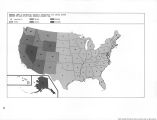| OCR Text |
Show application; effects of the various practices are not presently demonstrable in many cases; and the level of expenditure appears generally inadequate to achieve even minimal objectives within a reasonable time. If comprehensive data were provided pursuant to statutory directive, as we recommend, Congress should be able to establish realistic goals and priorities for watershed protection and management programs before it commits any substantial funds to broaden existing programs or initiate new ones. Since the Forest Service has extensive experimental research programs underway with respect to increasing water yield and the Bureau of Land Management has just instituted a comprehensive watershed evaluation study designed to obtain the answers to some of these questions, the agencies should be able to report rather promptly. Congress should then be able to provide guidelines to the agencies on fundamental questions such as (1) under what conditions, if any, preference should be given to watershed management programs and expenditures designed to increase water yields rather than provide strict maintenance or improvement of present watershed conditions; Dmetimes cascading downhill in wide, shallow streams. and (2) whether reduction of stream siltation from high silt-producing lands should take precedence over any or all other uses in certain regions. Retention and Acquisition Recommendation 58: "Watershed protection" should in specified, limited cases be: (1) a reason for retaining lands in Federal ownership; and (2) justification for land acquisition. One of the reasons for the establishment of the national forests, as stated in the Organic Act of 1897, was "for the purpose of securing favorable conditions of water flows." 15 The same rationale was reflected in the Weeks Act of 1911, which authorized the acquisition by the Secretary of Agriculture of private "forested, cut-over, or denuded lands within the watersheds of navigable streams as in his judgment may be necessary to the regulation of the flow of navigable streams." 16 The Multiple Use-Sustained Yield Act of 1960 17 recognized that the national forests were to be administered, inter alia, for "watershed" purposes, but whether this directive embodied only the earlier emphasis on stream flow regulation (with its "navigation" justification) or contemplated broader purposes is unclear. With respect to BLM lands, the Classification and Multiple Use Act of 1964 18 lists "watershed protection" as one of the land management purposes when lands are classified for retention in Federal ownership. The assumption underlying congressional policies for acquisition of private lands for "watershed protection" apparently was that Federal ownership would result generally in management practices and investments that had not been, nor were likely to be, undertaken by private landowners. However, the dereliction of the private sector with respect to watershed protection, which characterized the early part of the century, appears to have been largely superseded by improved watershed protection practices backed by state and Federal technical and financial assistance. Today, therefore, substantially identical watershed protection and management practices are conducted on both public and private lands. Expenditures on private lands in the 11 western states, under watershed protection programs developed over the last 40 years, exceed the level of similar expenditures on public lands. Several reasons « 16 U.S.C. § 475 (1964). "16 U.S.C. §515 (1964). 17 16 U.S.C. §§528-531 (1964). 18 43 U.S.C. §§1411-1418 (1964), as amended, (Supp. IV 1969). 151 |







































































































































































































































































































































































